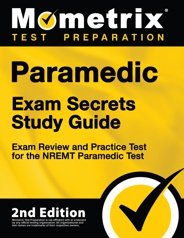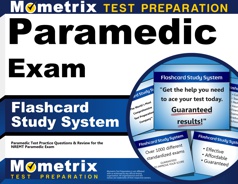A paramedic is an allied health professional specializing in providing emergency medical care for patients prior to their admission to a medical care provider, but to become one, aspiring paramedics must undergo a rigorous process of training and certification that ends with taking the Emergency Medical Technician (EMT) Exam for paramedics.
Click “Start Test” above to take a free Paramedic EMT practice test, and check out our premium-quality Paramedic test prep resources by clicking the links below!
What is the EMT Certification Test?
The Paramedic EMT exam is a certification exam administered by the National Registry of Emergency Medical Technicians (NREMT), an organization that serves as the nation’s EMS certification body. Those who pass the Paramedic EMT test are the only persons qualified to work as emergency medical technicians and paramedics.
After passing the Paramedic exam, you will receive a license or certification that marks you as a qualified paramedic. Whether you receive a license or a certification depends on your state, but the test remains the same for test takers regardless of the state in which they take the exam.
The National Registry of Emergency Medical Technicians recommends the following persons to take the test:
- Those who have recently completed or are currently enrolled in a paramedic education program. Please note that the EMT Test may only be taken by those who have taken a CAAHEP-accredited paramedic education program. Additionally, the program must have been finished within the past two years prior to a candidate’s registration for the exam.
- Those who are currently holders of an EMS license or certification. Current holders of an EMS license or certification are still required to accomplish 30 hours of approved continuing education training.
- Those who have a lapsed National Registry certification or lapsed state EMS license. This applies to persons with equivalent state-recognized paramedic certifications. However, you will have to undergo 30 hours of approved continuing education to qualify.
Check Out Mometrix's EMT Exam Study Guide for Paramedics
Get practice questions, video tutorials, and detailed study lessons
Get Your Study Guide
Paramedic Exam Outline
The Paramedic EMT exam was previously split into two exams, a cognitive exam and a psychomotor exam, both of which had to be passed in order to pass the full Paramedic exam. As of July 2024, the psychomotor exam has been phased out entirely.
The exam contains 110-150 multiple-choice questions, 20 of which are unscored, and you will be given a time limit of 3.5 hours. The 20 unscored questions are used to evaluate questions for future versions of the exam. They are unmarked, so you will not know which questions are scored and which are unscored.
The exam is split into six content areas:
| Content Area | Percent of Exam |
|---|---|
| Airway, Respiration, and Ventilation | 8%-12% |
| Cardiology and Resuscitation | 10%–14% |
| Trauma | 6%–10% |
| Medical/Obstetrics/Gynecology | 24%–28% |
| EMS Operations | 8%–12% |
| Clinical Judgment | 34%–38% |
How to Register for the Test
Candidates for the Emergency Medical Technician for Paramedics Exam must register an account on the NREMT website. You will then have to fill out a form that will ask for your social security number. After submitting the information, you will be taken to the online registration process where you will fill in your basic information and provide your role status as either a current Nationally Certified EMS Professional or a taker applying to become Nationally Certified.
Please note that your address information must be accurate if you are opting to have a printed card/certificate mailed to you.
There will be an application fee of $175, which will be charged for each attempt of the cognitive exam. If you change your mind, you may request a refund within 90 days of payment. You will also need to accomplish an Authorization to Test and a Psychomotor Authorization to Test prior to qualifying for the Paramedic EMT Exam.
Check Out Mometrix's EMT Exam Flashcards for Paramedics
Get complex subjects broken down into easily understandable concepts
Get Your Flashcards
Practice For the Exam the Best Way
How to Study Effectively
Your success on EMT test day depends not only on how many hours you put into preparing, but also on whether you prepared the right way. It’s good to check along the way to see whether your studying is paying off. One of the most effective ways to do this is by taking EMT exam practice tests to evaluate your progress. Practice tests are useful because they show exactly where you need to improve. Every time you take a free EMT practice test, pay special attention to these three groups of questions:
- The questions you got wrong
- The ones you had to guess on, even if you guessed right
- The ones you found difficult or slow to work through
This will show you exactly what your weak areas are, and where you need to devote more study time. Ask yourself why each of these questions gave you trouble. Was it because you didn’t understand the material? Was it because you didn’t remember the vocabulary? Do you need more repetitions on this type of question to build speed and confidence? Dig into those questions and figure out how you can strengthen your weak areas as you go back to review the material.
Answer Explanations
Additionally, many Paramedic EMT practice tests have a section explaining the answer choices. It can be tempting to read the explanation and think that you now have a good understanding of the concept. However, an explanation likely only covers part of the question’s broader context. Even if the explanation makes sense, go back and investigate every concept related to the question until you’re positive you have a thorough understanding.
Comprehend Each Topic
As you go along, keep in mind that the EMT exam practice test is just that: practice. Memorizing these questions and answers will not be very helpful on the actual test because it is unlikely to have any of the same exact questions. If you only know the right answers to the sample questions, you won’t be prepared for the real thing. Study the concepts until you understand them fully, and then you’ll be able to answer any question that shows up on the test.
Strategy for EMT Exam Practice
When you’re ready to start taking EMT practice tests, follow this strategy:
- Remove Limitations. Take the first test with no time constraints and with your notes and EMT exam study guide handy. Take your time and focus on applying the strategies you’ve learned.
- Time Yourself. Take the second practice test “open book” as well, but set a timer and practice pacing yourself to finish in time.
- Simulate Test Day. Take any other practice tests as if it were test day. Set a timer and put away your study materials. Sit at a table or desk in a quiet room, imagine yourself at the testing center, and answer questions as quickly and accurately as possible.
- Keep Practicing. Keep taking practice tests on a regular basis until you run out of practice tests or it’s time for the actual test. Your mind will be ready for the schedule and stress of test day, and you’ll be able to focus on recalling the material you’ve learned.
EMT Online Prep Course
If you want to be fully prepared, Mometrix offers an online EMT prep course designed to give you everything you need to succeed!
Here’s what you’ll find in the EMT course:
- 70+ Review Lessons Covering Every Topic
- Over 700 EMT Practice Questions
- 30+ Video Tutorials
- 550+ Digital Flashcards
- Money-back Guarantee
- Mobile Access
Everyone learns differently, so we’ve tailored the EMT online prep course to ensure every learner has what they need to prepare for the EMT exam.
Click below to check it out!
FAQs
Q
How do you study for the Paramedic EMT exam?
A
To study for the Paramedic EMT exam, check out the Mometrix flashcards and study guide, which includes additional practice tests. These invaluable resources include a risk-free, 1-year 100% money-back guarantee. Repetition and practice are key to adequate preparation.
Q
Is the Paramedic EMT exam hard?
A
Overall, the Paramedic EMT exam is somewhat difficult, as it is designed to assess important skills and knowledge. Because the Paramedic exam is computer-adaptive, the questions will proceed to get slightly harder as you go along, depending on which questions you answer correctly.
Q
What is the pass rate for the Paramedic EMT exam?
A
The pass rate for those taking the Paramedic EMT exam is 70%.
Q
How long is the Paramedic EMT exam?
A
Test-takers will be given 3.5 hours to complete the Paramedic EMT exam.
Q
What is the passing score for the EMT exam?
A
The AEMT exam is scored using a scaled system. This system takes your raw score, which is the number of questions you answered correctly, and converts it to a score that fits on a numerical scale of 100-1,500.
To pass, you will need to achieve a scaled score of at least 950. For every version of the AEMT exam, the number of questions that must be answered correctly to get a score of 950 can vary.
Your score and results of whether you passed the exam will be posted on your online account within two business days after you take the exam.
Q
When will I receive my Paramedic EMT exam scores?
A
Any information you may receive regarding your test scores prior to the official release of results is an unofficial result that may change depending on the criteria set by the NREMT, not your test administrator. These changes may arise due to errors discovered during the quality control process.
You can expect to see your Paramedic EMT exam results in your NREMT account within 3-8 business days after they arrive at the NREMT, provided that they are in good condition.
